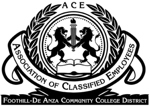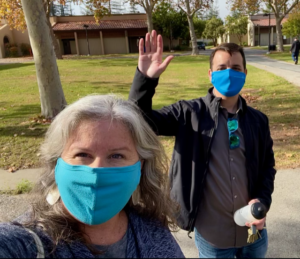ACE Members,
I’ve served as president for a little over 100 days. Throughout navigating unique challenges across the district, what has always brought me confidence is our contract agreement (LINK) and working alongside an amazing executive board. The first thing I do each day when I start my computer is open the agreement in a browser tab as a reference for enforcing workplace ground rules. When there’s an issue the contract doesn’t cover, I reach out to my fellow troublemakers. If you need something concrete to stand on or someone to help to resolve a workplace concern, follow my example: (1)know your contract and (2)contact a steward.
Stewards
What does an ACE Steward do? (I asked one for their answer)
I would say that as a steward I provide members assistance interpreting and clarifying the contract; provide consultation over potential violations regarding wages, hours of work and other conditions of employment described in the collective bargaining agreement; represent our members in the workplace; provide assistance with the grievance process.
Section 5.3 of our Constitution goes into detail regarding the duties of a Steward (LINK)
Who are our Stewards?
@Erika Flores (Chief Steward – De Anza)
@Adriana Garcia (Steward – De Anza)
@Anthony Caceres (Chief Steward – Central Services)
@Scott Olsen (President)
ACE is looking for a Foothill Chief Steward. Contact me if you are interested in the position. I’ll send out a separate announcement with additional details soon.
Congratulations to @Andre Meggerson on obtaining a new position at De Anza 🥳 Thank you for your years of excellent service.
Cost-of-Living Adjustment for 21-22 and 22-23
Currently negotiations are underway for a salary increase, but the distance between initial proposals is big. I recognize it’s alarming to see reactions like the Faculty Association’s work to contract and ACE’s guidance to not give away your work for free, but despite us doing “compassion and care work” we are essential workers and deserve be compensated fairly for our role in paving the way for the institution to succeed in its mission.
What makes 21-22 and 22-23 negotiations different from other years is that the COLA is being negotiated for all bargaining units at the same time. We are working hand-in-hand with FA, CSEA, Teamsters and POA. During this process when there’s a call for support, we’re going to do what we can to stand in solidarity.
Noise Made / Actions Taken
At the Trustees meeting (statement included below) I highlighted that it had been a year since the classification study had been approved and all members have yet to be paid. In addition to delays, we are struggling to resolve inaccuracies like overpayments and unilateral step adjustments which reduced March paychecks for members – most likely you saw a copy of our cease-and-desist as an immediate response. Chris White would repeatedly remind members to “always check your paystub” and I will begin to do the same. ACE has since met with HR and is actively working to resolve both issues – affected employees will be notified separately.
Retirees, I will follow up with information once I am provided with a specific payment date for what you are due. Thank you to those who submitted public comments to the Board of Trustees.
I’m looking forward to finalizing the classification study and beginning to work on future initiatives that continue to benefit members. ACE has negotiated great things in the past and we will continue to do so in the future.
Site Meetings (Check Outlook to Join)
De Anza/Central Services
Tue, April 19th Noon – 1:00 PM
Zoom
Foothill/ Central Services
Thu, April 21st Noon – 1:00 PM
Zoom
Events
403bwise.org Basics of Savings and Investing
Thu, April 21, 2022 4:00 PM – 5 PM PDT
Zoom
(Register)
“A Song for Cesar” documentary followed by a panel discussion
Fri, April 29, 2022 6:00 PM – 8:00 PM PDT
Smithwick Theatre, 12345 El Monte Road, Los Altos Hills, CA 94022
(Register via Eventbrite)
Take Care,
Scott Olsen (he/him) | ACE President
https://acefhda.org | olsenscott@fhda.edu
650-949-7789 | M-F 8:00am-5:00pm
Trustees,
It’s been one year since the classification study was approved by this board and ACE members have yet to be fully compensated accurately. I include the word “accurately” after being notified on March 17th that some were allegedly overpaid. On that same day ACE issued a demand for (1)a list of the employees who’ve been allegedly overpaid, (2)the amount of overpayment and (3)the reason they were overpaid. No response was received before employees were asked to sign a document agreeing to return money. A cease-and-desist letter citing labor code and ed code violations was sent to the district by our attorney group.
Background calculations that attempt to identify the logic behind the study’s back pay for March were not provided for most recipients, unlike for February. The lack of this information creates confusion and uncertainty for employees.
On March 31st employees began to question a “pay discrepancy” when they found their current paychecks were lower than in previous months. Their base salary had been unilaterally lowered as a result of moving them to a lower step without notice. Today ACE issued a similar demand for (1)a list of the affected employees, (2)the amount of discrepancy and (3)the reason for this discrepancy and (4)to meet and confer over the impact and implementation of salary disputes. These actions are contrary to negotiated agreements, violate California Labor Code section 222 and clearly an unfair labor practice.
Mental health was the underlying topic of this morning’s flex day. While individual self-care was promoted as a solution, in a relationship the onus to resolve an issue falls on both parties. As our employer I would ask that you find the capacity to provide advance warning, communicate clearly, respond to requests, and be accurate, especially when it comes to the topic of compensation. Modifying future behavior would reduce financial anxiety and stress for my members along with demonstrating dignity and respect.

